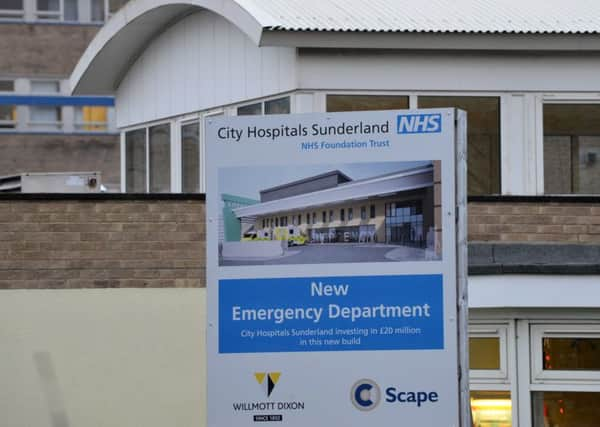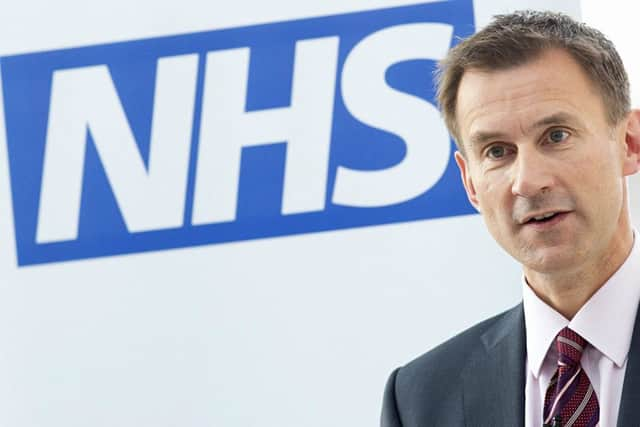New patient uses Sunderland Royal Hospital A&E department every three minutes


Statistics released by NHS Digital show that 140,037 patients went to the emergency ward in 2015/16, with 131,032, or 93.6%, waiting less than four hours for treatment.
The Department for Health target for trusts to treat A&E patients within four hours of arrival is 95%.


Advertisement
Hide AdAdvertisement
Hide AdOf all trusts in England, 91.9% of patients were seen in the target time frame during 2015/16.
A&Es across the country continue to be put under pressure, with attendances particularly high during winter.
Ken Bremner, chief executive of City Hospitals Sunderland and South Tyneside NHS Foundation Trusts, said: “The last few years have been particularly challenging ones for the NHS nationally in many ways, not least in terms of the ever-increasing demand on accident and emergency services, which we have experienced in our own trusts and which we continue to experience today.
“Despite this, our staff continue to do a magnificent job in ensuring our patients are managed quickly and safely through the system and receive the right care for their needs.


Advertisement
Hide AdAdvertisement
Hide Ad“We appreciate patients’ understanding and patience if they do come to A&E and find they have to wait longer than normal.
“They can be assured that our staff are doing their very best to attend to them as quickly as possible in order of clinical need.”
The news comes a week after NHS bosses warned thousands of patients used the North East’s A&E departments during the run-up to Christmas when they didn’t need to for ailments including broken finger nails, toothache and over-drinking alcohol.
Between December 1 and Christmas Day, over 53,000 people attended major A&E departments in hospitals across the region, yet less than 30%, just over 15,000 people, actually needed admission to hospital for emergency treatment.
Advertisement
Hide AdAdvertisement
Hide AdAt City Hospitals Sunderland, 6,469 people attended the Royal’s A&E department, despite only 36%, or 2,315 people, actually needed emergency treatment.
Emergency hospital teams are calling upon the public to stop misusing A&E services for minor ailments which are not serious or life threatening.
Trolley waits of more than 12 hours in A&E among elderly people have more than doubled in two years, the new figures also show.
Data shows a huge jump in the number of very long waits among those aged 70 and over - from 34,088 in 2013/14 to 88,252 in 2015/16.
Advertisement
Hide AdAdvertisement
Hide AdAmong all ages, there were 185,017 trolley waits of 12 hours or more in 2015/16 - up from 157,895 the year before and 87,213 in 2013/14.
Of the waits in 2015/16, 56,013 were for people over the age of 80.
Other data published by NHS Digital shows 37% of people going to A&E are discharged with no follow-up needed, while 20% are discharged to their GP and another 20% are admitted to hospital.
Monday is the busiest day of the week, the figures also showed.
Advertisement
Hide AdAdvertisement
Hide AdOn Monday, Health Secretary Jeremy Hunt suggested he planned to alter the four-hour target for patients to be dealt with in A&E, saying it should only apply to the most urgent cases.
Hospitals have not hit the target nationally since summer 2015.
Mr Hunt told MPs in the Commons that up to a third of patients do not need to be seen in A&E.
In 2014, Mr Hunt took his own children to A&E because he did not want to wait to see a GP.
Advertisement
Hide AdAdvertisement
Hide AdBut Chris Moulton, vice president of the Royal College of Emergency Medicine, said there were many valid cases among the 37% of people discharged with no follow-up.
He said: “Many people go to A&E departments and leave with the advice and reassurance they need.
“An example is a child who has been taken to A&E with a big lump on their head after falling over.
“We might check them over and say we think they’re OK and they are discharged, but that is still a good and valid use of an emergency department’s time.
Advertisement
Hide AdAdvertisement
Hide Ad“Even if we did get rid of that 37% of people from A&E, it still wouldn’t do anything about these old people laying on trolleys waiting for beds.”
Doctors’ leaders have claimed the Government’s plans to extend access to GPs in England are in “complete disarray”, after a report warned of “difficulties” recruiting and retaining enough family doctors to deliver them.
The National Audit Office said shortfalls in training places, increased part-time working and early retirement mean there may be 1,900 fewer GPs by 2020 than health authorities had predicted.
The Department of Health has promised additional funding and 5,000 extra doctors in general practice by 2020 to meet a Conservative election promise for weekend and evening access to GPs.
Advertisement
Hide AdAdvertisement
Hide AdBut the NAO report found that the department had failed to evaluate the cost-effectiveness and consequences of the proposals or to show that they can provide value for money from existing services.
Some 46% of practices already close for part of their “core hour” opening times of 8am to 6.30pm Monday to Friday.
Funding the extended hours commitment will require at least £230 per appointment hour for every 1,000 registered patients, compared with £154 during normal opening hours, said the watchdog.
The report found that efforts by NHS England and Health Education England to boost GP numbers are “at particular risk from falling retention, shortfalls in recruitment and increases in part-time working”, with just 3,019 out of 3,250 training places (93%) filled in 2016/17, up from 2,769 the previous year.
Advertisement
Hide AdAdvertisement
Hide Ad“The latest available data on part-time working in new GPs suggest that there may be 1,900 fewer full-time equivalent GPs by 2020 than Health Education England had estimated there would be,” the NAO warned.
The chairman of the British Medical Association’s GP committee, Chaand Nagpaul, described the report as “further evidence that the Government’s plans for extending patient access are in complete disarray”.
“Policy-makers have underestimated the number of GPs required to deliver their promises by almost 2,000,” said Dr Nagpaul.
“This comes at a time when the NHS is already suffering from a chronic shortage of GPs with one in three practices having unfilled doctor vacancies.”
Advertisement
Hide AdAdvertisement
Hide AdThe chairman of the influential House of Commons Public Accounts Committee, Labour MP Meg Hillier, accused ministers of “trying to shoehorn in seven-day access to general practice without a clear idea of the additional costs or benefits it will bring patients or taxpayers”.
Ms Hillier said: “This is on top of problems for patients in accessing their GP even during a standard working week, when nearly half of all practices close at some point during supposedly core hours, and practices are struggling to recruit and retain enough doctors for existing services.”
Liberal Democrat leader Tim Farron said: “Jeremy Hunt says he wants a seven-day NHS, but under his watch GP surgeries are struggling to stay open nine to five.”